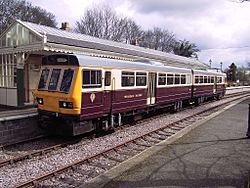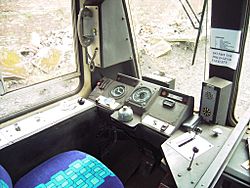British Rail Class 141 facts for kids
Quick facts for kids British Rail Class 141 Pacer |
|
|---|---|
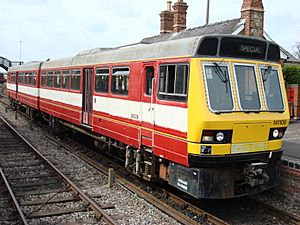
141108 at the Colne Valley Railway
|
|
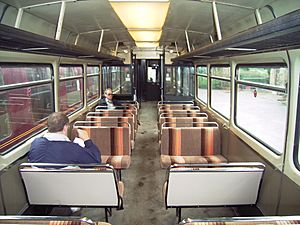
Interior of a Class 141.
|
|
| In service | 1984 - 2005 |
| Manufacturer | British Leyland |
| Order no. |
|
| Family name | Pacer |
| Refurbishment | 1988 - 1989 |
| Formation |
|
| Diagram |
|
| Fleet numbers |
|
| Capacity |
|
| Operator(s) |
|
| Depot(s) | Neville Hill |
| Line(s) served | West Yorkshire |
| Specifications | |
| Car body construction | Steel |
| Car length | 15.45 m (50.7 ft) |
| Width | 2.5 m (8 ft 2 in) |
| Height | 3.906 m (12.81 ft) |
| Articulated sections | 2 |
| Wheelbase | 9 m (30 ft) |
| Maximum speed | 75 mph (121 km/h) |
| Weight |
|
| Prime mover(s) | 1 × Leyland TL11 |
| Power output | 205 hp (153 kW) |
| Transmission | SCGR500 4-speed |
| Train heating |
|
| Bogies | AX1 |
| Braking system(s) | Air |
| Safety system(s) | AWS |
| Coupling system |
|
| Headlight type | Fluorescent |
| Track gauge | 1,435 mm (4 ft 8 1⁄2 in) standard gauge |
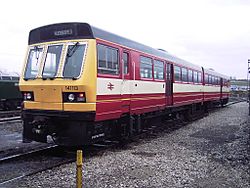
141113 standing at Swanwick shed, Midland Railway Butterley
The British Rail Class 141 was the first production model of the Pacer diesel multiple units. They were created because then British Rail had a large shortage of trains so rather than spending lots of money on expensive proper trains, they invented the Pacer. British Leyland at the time had a surplus in the production of bus bodies so the idea was to weld the bus body from an old bus on to a freight waggon chassis. The result of this was that pacers have notoriously poor suspension and are noisier around corners due to flanging (the squeaky noise that you'll sometimes hear when travelling by train). This makes them non-ideal passenger trains so they are now being replaced (or have been replaced in the case of the class 141) by new trains.
Images for kids

All content from Kiddle encyclopedia articles (including the article images and facts) can be freely used under Attribution-ShareAlike license, unless stated otherwise. Cite this article:
British Rail Class 141 Facts for Kids. Kiddle Encyclopedia.


